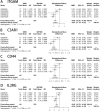Integrative analysis of metabolomics and transcriptomics to uncover biomarkers in sepsis
- PMID: 38678059
- PMCID: PMC11055861
- DOI: 10.1038/s41598-024-59400-0
Integrative analysis of metabolomics and transcriptomics to uncover biomarkers in sepsis
Abstract
To utilize metabolomics in conjunction with RNA sequencing to identify biomarkers in the blood of sepsis patients and discover novel targets for diagnosing and treating sepsis. In January 2019 and December 2020, blood samples were collected from a cohort of 16 patients diagnosed with sepsis and 11 patients diagnosed with systemic inflammatory response syndrome (SIRS). Non-targeted metabolomics analysis was conducted using liquid chromatography coupled with mass spectrometry (LC-MS/MS technology), while gene sequencing was performed using RNA sequencing. Afterward, the metabolite data and sequencing data underwent quality control and difference analysis, with a fold change (FC) greater than or equal to 2 and a false discovery rate (FDR) less than 0.05.Co-analysis was then performed to identify differential factors with consistent expression trends based on the metabolic pathway context; KEGG enrichment analysis was performed on the crossover factors, and Meta-analysis of the targets was performed at the transcriptome level using the public dataset. In the end, a total of five samples of single nucleated cells from peripheral blood (two normal controls, one with systemic inflammatory response syndrome, and two with sepsis) were collected and examined to determine the cellular location of the essential genes using 10× single cell RNA sequencing (scRNA-seq). A total of 485 genes and 1083 metabolites were found to be differentially expressed in the sepsis group compared to the SIRS group. Among these, 40 genes were found to be differentially expressed in both the metabolome and transcriptome. Functional enrichment analysis revealed that these genes were primarily involved in biological processes related to inflammatory response, immune regulation, and amino acid metabolism. Furthermore, a meta-analysis identified four genes, namely ITGAM, CD44, C3AR1, and IL2RG, which were highly expressed in the sepsis group compared to the normal group (P < 0.05). Additionally, scRNA-seq analysis revealed that the core genes ITGAM and C3AR1 were predominantly localized within the macrophage lineage. The primary genes ITGAM and C3AR1 exhibit predominant expression in macrophages, which play a significant role in inflammatory and immune responses. Moreover, these genes show elevated expression levels in the plasma of individuals with sepsis, indicating their potential as valuable subjects for further research in sepsis.
Keywords: Biomarkers; Metabolomics; RNA sequencing; Sepsis; Single-cell RNA sequencing.
© 2024. The Author(s).
Conflict of interest statement
The authors declare no competing interests.
Figures





Similar articles
-
Proteomics Combined with RNA Sequencing to Screen Biomarkers of Sepsis.Infect Drug Resist. 2022 Sep 21;15:5575-5587. doi: 10.2147/IDR.S380137. eCollection 2022. Infect Drug Resist. 2022. PMID: 36172619 Free PMC article.
-
Exploring the prognostic and diagnostic value of lactylation-related genes in sepsis.Sci Rep. 2024 Oct 4;14(1):23130. doi: 10.1038/s41598-024-74040-0. Sci Rep. 2024. PMID: 39367086 Free PMC article.
-
Targeted metabolomics for discrimination of systemic inflammatory disorders in critically ill patients.J Lipid Res. 2012 Jul;53(7):1369-75. doi: 10.1194/jlr.P023309. Epub 2012 May 11. J Lipid Res. 2012. PMID: 22581935 Free PMC article.
-
The Diagnostic Utility of Host RNA Biosignatures in Adult Patients With Sepsis: A Systematic Review and Meta-Analysis.Crit Care Explor. 2025 Jan 31;7(2):e1212. doi: 10.1097/CCE.0000000000001212. eCollection 2025 Feb 1. Crit Care Explor. 2025. PMID: 39888601 Free PMC article.
-
Immune therapy in sepsis: Are we ready to try again?J Intensive Care Soc. 2018 Nov;19(4):326-344. doi: 10.1177/1751143718765407. Epub 2018 Apr 4. J Intensive Care Soc. 2018. PMID: 30515242 Free PMC article. Review.
Cited by
-
Multi Omics Applications in Biological Systems.Curr Issues Mol Biol. 2024 Jun 11;46(6):5777-5793. doi: 10.3390/cimb46060345. Curr Issues Mol Biol. 2024. PMID: 38921016 Free PMC article. Review.
-
Dissecting inflammation in the immunemetabolomic era.Cell Mol Life Sci. 2025 Apr 28;82(1):182. doi: 10.1007/s00018-025-05715-8. Cell Mol Life Sci. 2025. PMID: 40293552 Free PMC article. Review.
-
Multi-omics decodes host-specific and environmental microbiome interactions in sepsis.Front Microbiol. 2025 Jun 26;16:1618177. doi: 10.3389/fmicb.2025.1618177. eCollection 2025. Front Microbiol. 2025. PMID: 40641871 Free PMC article. Review.
References
-
- Rudd KE, Johnson SC, Agesa KM, Shackelford KA, Tsoi D, Kievlan DR, Colombara DV, Ikuta KS, Kissoon N, Finfer S, et al. Global, regional, and national sepsis incidence and mortality, 1990–2017: Analysis for the global burden of disease study. Lancet. 2020;395(10219):200–211. doi: 10.1016/S0140-6736(19)32989-7. - DOI - PMC - PubMed
Publication types
MeSH terms
Substances
Grants and funding
LinkOut - more resources
Full Text Sources
Medical
Research Materials
Miscellaneous

